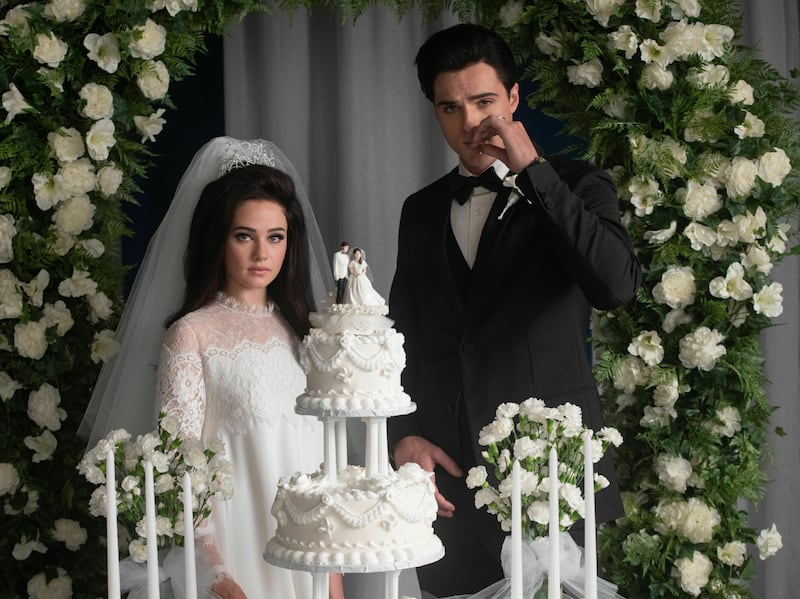Don’t tell the health authorities, but, after years of decline, cigarettes are having a moment in the movies. Among the current Oscar contenders, Cillian Murphy’s Robert Oppenheimer puffs his way through the Manhattan Project and his ensuing travails. In Maestro, whenever he’s not actually conducting, Bradley Cooper, as Leonard Bernstein, is rarely to be seen without a cigarette in his hand. In The Holdovers, bartered Winstons are a significant plot point, while Da’Vine Joy Randolph’s Oscar-nominated performance is wreathed in blue smoke. Other forms of oral gratification may dominate the discourse about Saltburn, but there’s plenty of tobacco action. And Jacob Elordi’s Elvis Presley is more attached to his Marlboros than his cheeseburgers in Sofia Coppola’s Priscilla.
If you were to invite a time traveller from the 1980s to visit us today, the most obvious change they would notice would surely be the banishment of cigarettes from most walks of life. If that traveller offered you a return trip to their own era, you would reel at the stench of stale smoke rising from people, clothes, furniture ... everything.
The smoking ban in Irish pubs is 20 years old this year, so you need to be in your late 30s at least to properly remember what it used to be like. The Irish law had been preceded by successive bans around the world on smoking on buses, on planes, in cinemas and in offices. As the net tightened, Hollywood, under pressure from the antismoking lobby, began to cut back on the fags. Since 2007 the Motion Picture Association of America has encouraged studios to eliminate smoking from all youth-rated films. Netflix followed suit a few years later.
It was about time. Hollywood and Big Tobacco were entwined for decades, with stars endorsing brands and some releases actually sponsored by tobacco companies. The relationship began to go underground when restrictions on cigarette advertising were introduced in the 1970s and product-placement deals assumed an even greater importance. In 1983 the president of Philip Morris told a marketing meeting: “We must continue to exploit new opportunities to get cigarettes on screen and into the hands of smokers.” In 1989 the same company paid $350,000 to have its Lark brand featured in (appropriately) Licence to Kill.
‘I am divorced at 60, envious of my ex-husband’s new life and struggling with loneliness’
Look inside the most expensive house sold in Dublin so far this year
‘I learned about Irish time. People arrive late and think they are on time’
Bishop Casey’s Buried Secrets review: ‘He had no fear of being caught’

The backlash to all this was understandable but occasionally ridiculous. I recall as an editor in the mid-noughties being informed by an officious busybody that we were now legally barred from ever publishing a photograph of anybody smoking cigarettes. Ever. Such excesses faded away soon enough. For a while, though, smoking was extremely rare on screen, even when realism might have called for it in period dramas.
The first sign of change came with Mad Men, in which cigarettes were both central to the sense of time and place and essential to the portrayal of the central characters’ neuroses. Don Draper now looks like the prototype for the nicotine-stained postwar existential dread of Murphy and Cooper’s performances. Death hangs over all of them. Bernstein and Oppenheimer both succumbed to smoking-related diseases, a fact that hangs over the two biopics but to which they never refer, although Maestro does portray a death from cancer in some detail.
[ James Bond: 007’s best and worst movies, rankedOpens in new window ]
Perhaps it’s because a full generation has now passed that so many film-makers have fixed on smoking as the perfect visual device to evoke an era, a character or a predicament. In doing so they are drawing on a rich cinematic history. There are few better props than the cigarette. In more strait-laced times, they served to indicate that someone (a) was available for sex, (b) had just had sex or (c) was up for a bit more sex. But there was much more to it than that. The flare of match against tip could signal danger, excitement, intimacy or all of those at once.
Cigarettes now allow film-makers a a shorthand for the strangeness of the past, even the very recent past. Emerald Fennell’s Saltburn is set in 2007, just before the UK’s smoking ban. “For me, that felt like a very specific threshold because for anyone in their 20s now or their teens now, that’s unfathomable that you could go to a bar or a pub and smoke a cigarette,” Fennell told Vanity Fair. “It becomes a sort of period drama even though it also very much doesn’t feel that way.”
Effectively, though, film-makers are taking up the habit for the same reasons that millions of young people did in the past. The classification of cigarettes as “adult content” in films and streaming dramas gave them an aura of retro forbidden fruit. Cigarettes are edgy. Cigarettes are sexy. Cigarettes can kill you horribly. And in movies you can’t even smell them. What’s not to like?





